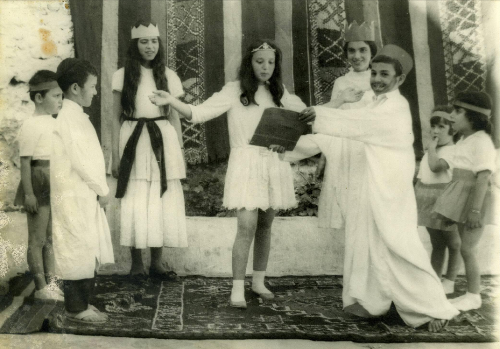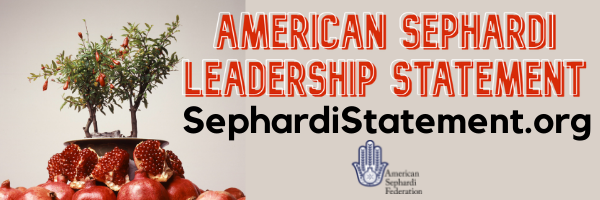Classic Sephardi Sages on Purim  : Costumes, Charity, & Communitas
: Costumes, Charity, & Communitas


Purim Alegre!
!פורים שמח
From your friends at
The American Sephardi Federation
In honor of Purim, the ASF’s Sephardi World Weekly is pleased to offer the following “Letter from the Land of Israel”:
The holiday of Purim is distinguished by a number of fascinating customs and traditions. The most popular custom is to dress up in festive costumes, but, truth be told, this is a relatively recent practice dating back to Medieval times. Purim traditions with roots in the Talmudic and Biblical eras include giving charity, sending gifts of food to friends and acquaintances, participating in a festive meal, and listening to two public readings of the Megilat Esther (Book of Esther).
These Talmudic and Biblical traditions are practiced in a very particular way on Purim. Consider the giving of charity. The rule on Purim is to give charity to at least two people, but we are also highly encouraged to give charity to anyone who asks.
At first glance, this last directive is very strange. After all, when it comes to giving charity, the great Andalusian sage, Rabbi Moses ben Maimon (Rambam/Maimonides: 1135-1205), taught that the highest form of charity is to help someone become self-sufficient. In what way does indiscriminate giving help anyone become self-sufficient? Maimonides also teaches that charity is best given anonymously. The commandment to give to whomever asks obviously transgresses this rule, too.
Most fundamentally, however, Jewish law doesn’t obligate us to give charity to anyone who asks. We’re instead obligated to check, to the degree possible, that the person asking for charity is honestly presenting his or her needs.
How can we understand this strange aspect of the Purim holiday?
The great Spanish Talmudist, kabbalist, Biblical commentator, and physician, Rabbi Moses ben Nachman (Ramban/Nachmanides: 1194–1270), offers a very interesting answer in his commentary to the Talmudic tractate of Bava Metzia (78b): “We shouldn’t be fastidious [on Purim] and say, ‘this poor person is worthy,’ while, ‘this poor person isn’t worthy.’ Rather, we give to everyone so that everyone will share in our joy, whether the person is fitting or isn’t fitting. For it is written, ‘Days of feasting and joy,’ and it is also written, ‘giving presents of food to one another (and gifts to the poor)’ (Esther 9:22).”
According to Nachmanides, we give charity on Purim in order to share our joy with others, without inquiring into the worthiness of the recipient. He further understands that charity on Purim is an extension of the practice to send gifts of food to friends and acquaintances. Put together, this means that, from Nachmanides’ perspective, the charity that we give on Purim isn’t really charity in the conventional sense. We don’t give charity on Purim in order to help those in need. Rather, we give charity on Purim—to anyone and everyone who asks—in order to strengthen communal unity.
Continue reading below…
~~~~~~~

The American Sephardi Federation invites all individuals, communities, and organizations who share our vision & principles to join us in signing the American Sephardi Leadership Statement!
Please also support the ASF with a generous, tax-deductible contribution so we can continue to cultivate and advocate, preserve and promote, as well as educate and empower!
~~~~~~~
Nachmanides’ interpretation fits in with the entire tenor of the Purim holiday. The traditions of Purim—sending gifts of food to friends and acquaintances, participating in a festive meal, and listening to two public readings of the Book of Esther—all aim at strengthening our ties to our fellow Jews. Nachmanides teaches that we likewise give charity to anyone who asks on Purim in order to increase love between Jews. And in case one wonders if we aren’t liable to give to someone who isn’t worthy in the process, the answer, on Purim, is that every Jew is worthy of our love.
This perspective on the expansive character of the Purim holiday can help us to better appreciate, in turn, the relatively recent custom of wearing costumes on Purim. In strengthening communal unity, we break down boundaries and, to use the terminology of the 20th century sociologist, Victor Turner, create a liminal reality in which day-to-day hierarchies are dissolved and communitas, an unstructured feeling of communal togetherness, emerges in its place. Dressing-up in costume likewise contributes to creating this liminal, communal space.
As for the question of why this unstructured feeling of togetherness is fitting for Purim, the answer is very basic and, indeed, almost primal. On Purim, all Jews were in danger of becoming victims of Haman’s genocidal plan. Haman didn’t distinguish between different kinds of Jews or Jewish communities; he wanted to annihilate them all. But all Jews, without distinction, benefited from the miraculous turn of events in which Haman’s plan was frustrated and the Jew people emerged triumphant. Purim traditions also encourage us to strengthen our connection to all Jews, without distinction.
The American Sephardi Federation wishes all of our friends a festive Purim filled with communal joy and togetherness. If there’s one thing that we can learn from antisemites like Haman, it’s that they don’t make distinctions between Jews. In our basic love for other Jews, we shouldn’t make any distinctions, either.
Purim Sameach!
The American Sephardi Federation

~~~~~~~
Photo credit: “La scène d’Esther,” Alliance Israélite Universelle, Inezgane, Morocco, Date Unknown (Photo courtesy of Ben Saïd Mohamed/AIU Library)
~~~~~~~